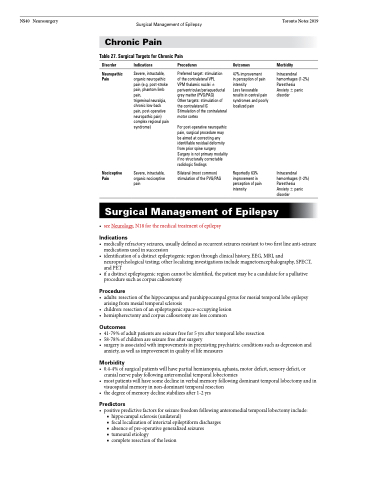Page 838 - TNFlipTest
P. 838
NS40 Neurosurgery
Surgical Management of Epilepsy
Toronto Notes 2019
Chronic Pain
Table 27. Surgical Targets for Chronic Pain
Disorder
Neuropathic Pain
Indications
Severe, intractable, organic neuropathic pain (e.g. post-stroke pain, phantom limb pain,
trigeminal neuralgia, chronic low-back pain, post-operative neuropathic pain) complex regional pain syndrome)
Severe, intractable, organic nociceptive pain
Procedures
Preferred target: stimulation of the contralateral VPL
VPM thalamic nuclei ± periventricular/periaqueductal grey matter (PVG/PAG)
Other targets: stimulation of the contralateral IC Stimulation of the contralateral motor cortex
For post-operative neuropathic pain, surgical procedure may be aimed at correcting any identifiable residual deformity from prior spine surgery Surgery is not primary modality if no structurally correctable radiologic findings
Bilateral (most common) stimulation of the PVG/PAG
Outcomes
47% improvement
in perception of pain intensity
Less favourable results in central pain syndromes and poorly localized pain
Reportedly 63% improvement in perception of pain intensity
Morbidity
Intracerebral hemorrhages (1-2%) Paresthesia
Anxiety ± panic disorder
Nociceptive Pain
Intracerebral hemorrhages (1-2%) Paresthesia
Anxiety ± panic disorder
Surgical Management of Epilepsy
• seeNeurology,N18forthemedicaltreatmentofepilepsy
Indications
• medicallyrefractoryseizures,usuallydefinedasrecurrentseizuresresistanttotwofirstlineanti-seizure medications used in succession
• identificationofadistinctepileptogenicregionthroughclinicalhistory,EEG,MRI,and neuropsychological testing; other localizing investigations include magnetoencephalography, SPECT, and PET
• ifadistinctepileptogenicregioncannotbeidentified,thepatientmaybeacandidateforapalliative procedure such as corpus callosotomy
Procedure
• adults:resectionofthehippocampusandparahippocampalgyrusformesialtemporallobeepilepsy arising from mesial temporal sclerosis
• children:resectionofanepileptogenicspace-occupyinglesion
• hemispherectomyandcorpuscallosotomyarelesscommon
Outcomes
• 41-79%ofadultpatientsareseizurefreefor5yrsaftertemporalloberesection
• 58-78%ofchildrenareseizurefreeaftersurgery
• surgeryisassociatedwithimprovementsinpreexistingpsychiatricconditionssuchasdepressionand
anxiety, as well as improvement in quality of life measures
Morbidity
• 0.4-4%ofsurgicalpatientswillhavepartialhemianopsia,aphasia,motordeficit,sensorydeficit,or cranial nerve palsy following anteromedial temporal lobectomies
• mostpatientswillhavesomedeclineinverbalmemoryfollowingdominanttemporallobectomyandin visuospatial memory in non-dominant temporal resection
• thedegreeofmemorydeclinestabilizesafter1-2yrs
Predictors
• positivepredictivefactorsforseizurefreedomfollowinganteromedialtemporallobectomyinclude: ■ hippocampal sclerosis (unilateral)
■ focal localization of interictal epileptiform discharges
■ absence of pre-operative generalized seizures
■ tumoural etiology
■ complete resection of the lesion


